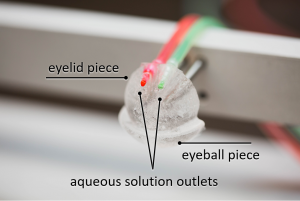When it’s not practical to measure contact lens performance in vivo, what is the best way to simulate the ocular environment? While we can extrapolate results to predict in vivo lens performance, conventional in vitro methods are limited by conditions too far removed from the human eye.
While Chau-Minh Phan and Hendrik Walther were not the first to try to come up with a better in vitro system to test contact lens deposition and drug delivery, their tenacious approach in developing various iterations of the OcuFlow has produced a remarkable, patented device capable of simulating key aspects of the natural blink.
In addition to incorporating a range of motion representative of the lid’s vertical “blink” movement, the device:
- Considers the intermittent air exposure that occurs between blinks;
- Can tailor and mimic fluid volume and flow of the natural tear film;
- Releases adjustable amounts of test solution (i.e. artificial tears, protein and lipid solutions) separately via separate sources;
- Collects flow-through solution for in vitro analysis;
- Programs blink rate and extent of mechanical rubbing.


More about the Ocuflow:
Phan C-M, Walther H, Gao H, Rossy J, Subbaraman LN, Jones L. Development of an in vitro ocular platform to test contact lenses. J Vis Exp 2016;110: e53907.
Walther H, Phan C-M, Qiao H, Liu Y, Subbaraman L, Jones L. In vitro eye model to simulate the impact of blinking on contact lens deposition and drug delivery. Optom Vis Sci 2016;93: E-abstract 160101.





